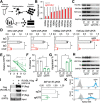Epigenetic Control of Translation Checkpoint and Tumor Progression via RUVBL1-EEF1A1 Axis
- PMID: 37075745
- PMCID: PMC10265057
- DOI: 10.1002/advs.202206584
Epigenetic Control of Translation Checkpoint and Tumor Progression via RUVBL1-EEF1A1 Axis
Erratum in
-
Correction to "Epigenetic Control of Translation Checkpoint and Tumor Progression via RUVBL1-EEF1A1 Axis".Adv Sci (Weinh). 2025 Nov 6:e19908. doi: 10.1002/advs.202519908. Online ahead of print. Adv Sci (Weinh). 2025. PMID: 41199425 No abstract available.
Abstract
Epigenetic dysregulation is reported in multiple cancers including Ewing sarcoma (EwS). However, the epigenetic networks underlying the maintenance of oncogenic signaling and therapeutic response remain unclear. Using a series of epigenetics- and complex-focused CRISPR screens, RUVBL1, the ATPase component of NuA4 histone acetyltransferase complex, is identified to be essential for EwS tumor progression. Suppression of RUVBL1 leads to attenuated tumor growth, loss of histone H4 acetylation, and ablated MYC signaling. Mechanistically, RUVBL1 controls MYC chromatin binding and modulates the MYC-driven EEF1A1 expression and thus protein synthesis. High-density CRISPR gene body scan pinpoints the critical MYC interacting residue in RUVBL1. Finally, this study reveals the synergism between RUVBL1 suppression and pharmacological inhibition of MYC in EwS xenografts and patient-derived samples. These results indicate that the dynamic interplay between chromatin remodelers, oncogenic transcription factors, and protein translation machinery can provide novel opportunities for combination cancer therapy.
Keywords: EEF1A1; Ewing sarcoma; KAT5; MYC; RUVBL1; epigenetic.
© 2023 The Authors. Advanced Science published by Wiley-VCH GmbH.
Conflict of interest statement
J.C. is a scientific founder of Genovel Biotech Corp. and holds equities with the company, and is also a Scientific Advisor for Race Oncology.
Figures






References
-
- a) Delattre O., Zucman J., Plougastel B., Desmaze C., Melot T., Peter M., Kovar H., Joubert I., de Jong P., Rouleau G., Aurias A., Thomas G., Nature 1992, 359, 162; - PubMed
- b) May W. A., Gishizky M. L., Lessnick S. L., Lunsford L. B., Lewis B. C., Delattre O., Zucman J., Thomas G., Denny C. T., Proc. Natl. Acad. Sci. USA 1993, 90, 5752; - PMC - PubMed
- c) Grohar P. J., Kim S., Rivera G. O. R., Sen N., Haddock S., Harlow M. L., Maloney N. K., Zhu J., O'Neill M., Jones T. L., Huppi K., Grandin M., Gehlhaus K., Klumpp‐Thomas C. A., Buehler E., Helman L. J., Martin S. E., Caplen N. J., Cell Rep. 2016, 14, 598. - PMC - PubMed
-
- a) Dauphinot L., De Oliveira C., Melot T., Sevenet N., Thomas V., Weissman B. E., Delattre O., Oncogene 2001, 20, 3258; - PubMed
- b) Prieur A., Tirode F., Cohen P., Delattre O., Mol. Cell. Biol. 2004, 24, 7275; - PMC - PubMed
- c) Bilke S., Schwentner R., Yang F., Kauer M., Jug G., Walker R. L., Davis S., Zhu Y. J., Pineda M., Meltzer P. S., Kovar H., Genome Res. 2013, 23, 1797; - PMC - PubMed
- d) Aynaud M. M., Mirabeau O., Gruel N., Grossetete S., Boeva V., Durand S., Surdez D., Saulnier O., Zaidi S., Gribkova S., Fouche A., Kairov U., Raynal V., Tirode F., Grunewald T. G. P., Bohec M., Baulande S., Janoueix‐Lerosey I., Vert J. P., Barillot E., Delattre O., Zinovyev A., Cell Rep. 2020, 30, 1767. - PubMed
-
- a) Brohl A. S., Solomon D. A., Chang W., Wang J., Song Y., Sindiri S., Patidar R., Hurd L., Chen L., Shern J. F., Liao H., Wen X., Gerard J., Kim J. S., Lopez Guerrero J. A., Machado I., Wai D. H., Picci P., Triche T., Horvai A. E., Miettinen M., Wei J. S., Catchpool D., Llombart‐Bosch A., Waldman T., Khan J., PLoS Genet. 2014, 10, e1004475; - PMC - PubMed
- b) Crompton B. D., Stewart C., Taylor‐Weiner A., Alexe G., Kurek K. C., Calicchio M. L., Kiezun A., Carter S. L., Shukla S. A., Mehta S. S., Thorner A. R., de Torres C., Lavarino C., Sunol M., McKenna A., Sivachenko A., Cibulskis K., Lawrence M. S., Stojanov P., Rosenberg M., Ambrogio L., Auclair D., Seepo S., Blumenstiel B., DeFelice M., Imaz‐Rosshandler I., Schwarz‐Cruz Y. C. A., Rivera M. N., Rodriguez‐Galindo C., Fleming M. D., et al., Cancer Discovery 2014, 4, 1326; - PubMed
- c) Dharia N. V., Kugener G., Guenther L. M., Malone C. F., Durbin A. D., Hong A. L., Howard T. P., Bandopadhayay P., Wechsler C. S., Fung I., Warren A. C., Dempster J. M., Krill‐Burger J. M., Paolella B. R., Moh P., Jha N., Tang A., Montgomery P., Boehm J. S., Hahn W. C., Roberts C. W. M., McFarland J. M., Tsherniak A., Golub T. R., Vazquez F., Stegmaier K., Nat. Genet. 2021, 53, 529. - PMC - PubMed
Publication types
MeSH terms
Substances
Grants and funding
LinkOut - more resources
Full Text Sources
Molecular Biology Databases
Research Materials
Miscellaneous
